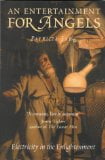 An Entertainment for Angels: Electricity in the Enlightenment
An Entertainment for Angels: Electricity in the Enlightenment
by Patricia Fara
Icon Books, £9.99, ISBN 1840463481
“Electricity has one considerable advantage over most other branches of science, as it both furnishes matter of speculation for philosophers and of entertainment for all persons promiscuously.” Thus Joseph Priestly in the 1790s, providing a succinct summary of the subject of this thoughtful and lucid book by Patricia Fara, an historian of science and an expert on 18th century magnetism.
Between about 1730 and 1790 entrepreneurial philosophers and self-styled “electricians” (not scientists yet – that word would not appear for another forty years) like Benjamin Franklin, Volta, Nollet, Boyle and Galvani began the work that would one day make a world run by electricity possible.
While theories about electricity and magnetism were plentiful, money and resources were not and for most experimenters publicity and the ability to earn money from entertaining shows and practical devices were as important as obtaining and publishing results. Hence the long running Anglo-American dispute over pointed versus rounded lightning conductors, the popular treatments available at the London Electrical Dispensary and Graham’s (literally) sparky “Celestial Bed”.
The history of scientific discovery is never a simple, linear narrative progressing towards the inevitable triumphant conclusion and Fara charts the usual false starts, blind alleys and squabbles that are as much personal as theoretical. Distinct national schools were important too: the French favouring an algebraic approach to their experiments, the British tending towards theologically flavoured theories concerning aethers, particles and “the Electrical fluid”.
Once the dramatic effect of electricity on isolated muscles had been shown, thoughts about treating the paralysed or resuscitating the dead inevitably followed, leading to some gruesome experiments on fresh corpses and subsequent speculation about the link between life, death and electricity. Speculation that would lead Mary Shelley, whose husband had enthused as an Oxford student over ‘a new engine’ (the galvanic battery), to produce in 1818 an enduring literary classic describing the career of a certain fictional experimenter by the name of Frankenstein.



